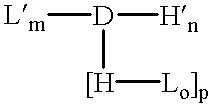Amphiphilic drug-oligomer conjugates with hydroyzable lipophile components and methods for making and using the same
a technology of lipophiles and amphiphilic drugs, applied in the direction of antibody medical ingredients, depsipeptides, peptide/protein ingredients, etc., can solve the problems of limited usefulness of polypeptides as therapeutic agents, inability to adequately administer, and difficulty in oral administration, so as to facilitate oral delivery and prolong the duration of activity in the bloodstream. , the effect of prolonging the duration of activity
- Summary
- Abstract
- Description
- Claims
- Application Information
AI Technical Summary
Benefits of technology
Problems solved by technology
Method used
Image
Examples
Embodiment Construction
The present invention broadly relates to therapeutic and / or diagnostic drug-oligomer conjugates wherein a drug molecule is covalently bonded to a oligomer to form an amphiphilic conjugate. The oligomers comprise at least one hydrophilic moiety and least one lipophilic moiety. The moieties are variously linked by hydrolyzable bonds, such that upon hydrolysis of the hydrolyzable bond, an active drug-hydrophile (D--H) conjugate remains. The oligomers can advantageously facilitate oral delivery while extending onset of activity of the polypeptide-oligomer conjugate in the blood stream.
The drug-oligomer conjugates are generally arranged as D--H--L or D--H--H'--L, wherein the H--L and H--H' bonds can be hydrolyzed in the blood stream to leave the D--H conjugate circulating in the blood stream. It will be appreciated that the various oligomers described herein (e.g., --H--L; --H--H'--L; --H--S--L; --H--S--H'--L; and --H--H'--S--L) are not to viewed as exclusive;...
PUM
| Property | Measurement | Unit |
|---|---|---|
| time | aaaaa | aaaaa |
| hydrophilic | aaaaa | aaaaa |
| lipophilic | aaaaa | aaaaa |
Abstract
Description
Claims
Application Information
 Login to View More
Login to View More - R&D
- Intellectual Property
- Life Sciences
- Materials
- Tech Scout
- Unparalleled Data Quality
- Higher Quality Content
- 60% Fewer Hallucinations
Browse by: Latest US Patents, China's latest patents, Technical Efficacy Thesaurus, Application Domain, Technology Topic, Popular Technical Reports.
© 2025 PatSnap. All rights reserved.Legal|Privacy policy|Modern Slavery Act Transparency Statement|Sitemap|About US| Contact US: help@patsnap.com



